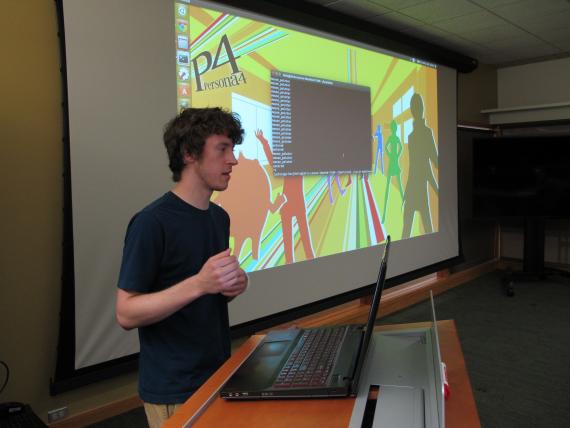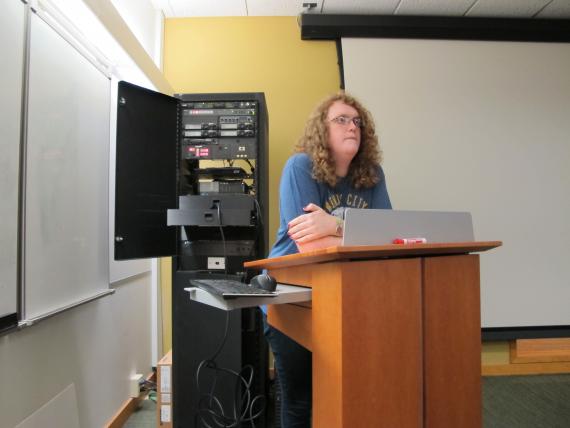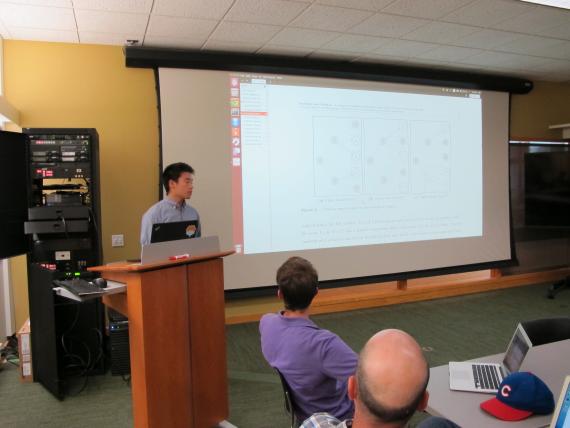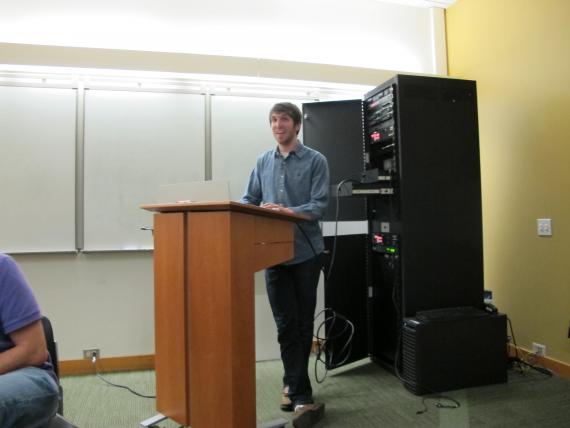July 31, 2015
by Benjamin Recchie
On July 28, the Research Computing Center’s staff gathered for the inaugural RCC Student Demo Day, a chance for everyone to come together and learn about the projects RCC’s student workers are spending their summer on. Here’s what we heard about.
Chris Eidsmoe
One of the RCC’s most unusual pieces of equipment is the Interactive Visualization Workbench (IVW), a table-sized touchscreen-surfaced computer coupled to a 3D projector and head-tracking equipment; a user with the right goggles can see an image in 3D and view it from any angle. The IVW was largely hand-built, running on custom software from a group at the University of Minnesota. Chris, a rising third-year, is using an open-source version of the original software to extend the functionality of the device. This includes setting up keyboard commands (instead of a merely graphical interface) and modifying the rendering engine to handle any common 3D image file.
Devon Compton
Devon graduated from the College in June and is spending their last few weeks at RCC winding things up and handling support ticket requests. They're also updating RCC’s documentation for its big memory nodes and debugging the installation of the XMIPP visualization software, which is used by research groups to visualize results from electron microscopy.
Jerry Chee
Rising third-year Jerry, RCC’s first summer Metcalf Intern, is working on the stochastic integer problem research of Burhaneddin Sandıkçı, associate professor of operations management at Chicago Booth. Sandıkçı’s code finds the best input values for calculations based on an enormous decision tree. Part of it includes calculations to define both the lower and upper bounds of the solutions. RCC has already helped Sandıkçı optimize the calculation of the lower bound via parallel computing; Chee is working on optimizing the code for the upper bound as well.
Matthew Best
Matt, a graduate student in the Committee on Computational Neuroscience, is working on developing data management plans for RCC users. Funding agencies such as the National Science Foundation and the National Institutes for Health now require that researchers who receive grants have plans to store and share their data over a period of many years; this is presenting a new challenge for researchers used to storing data files on Dropbox or on a few CDs on the shelf. In addition, he points out, “the data management solutions that work well in a chemistry lab might not make sense for a neuroscience lab,” so it’s important to avoid a one-size-fits all solution. Matt is talking with the University of Chicago Library and is working on a system that would make uploading researchers’ data quick and seamless.
Will McFadden
Data centers are energy-hungry beasts, consuming 2% of all US energy use, explains Will McFadden, a graduate student in biophysical sciences, and RCC’s supercomputing cluster Midway is no different. He’s exploring Midway’s energy consumption patterns, trying to find a way to schedule jobs on it more efficiently. His research revealed that the power consumption of Midway can be predicted fairly accurately given the time of day and year, suggesting that shifting some jobs to times when electricity is cheaper (such as late at night when most household appliances are off, or on mild days during the summer when demand for air conditioning isn’t as high) could save on the University’s electricity budget while still providing good service to users. Another alternative is to turn off some of Midway’s idle nodes, not all of which are needed at all times. Will found that shutting down nodes after 7 hours of idleness “would save as much electricity as my apartment uses in a month,” but noted that further investigation will be needed to account for the time and electricity needed to restart a node. After all, what’s the point of a supercomputer if it’s not ready to supercompute when you need it?




